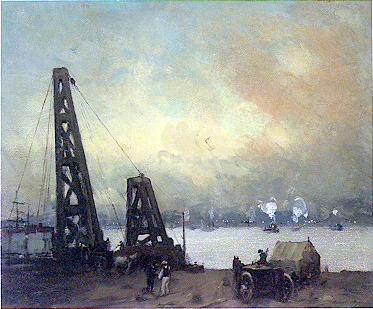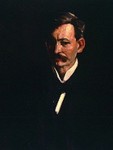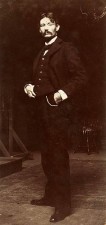
Robert Henri
American, 1865-1929
Derricks on the North River, 1902
oil on canvas
26 x 32 in.
SBMA, Museum purchase for the Preston Morton Collection, with funds provided by the Chalifoux Fund
1977.45

Self-portrait dated 1913
"I am interested in art as a means of living a life; not as a means of making a living.”
“The man who has honesty, integrity, the love of inquiry, the desire to see beyond, is ready to appreciate good art. He needs no one to give him an 'Art Education'; he is already qualified. He needs but to see pictures with his active mind, look into them for the things that belong to him, and he will find soon enough in himself an art connoisseur and an art lover of the first order.“
- Robert Henri
RESEARCH PAPER
Derricks on the North River, executed in 1902, is an oil on canvas measuring 26 x 32 inches. This cityscape is an exceptionally fine example of Henri’s expressive, rapid brushwork. The paint is thickly and richly applied, in a wet into wet manner, with some areas of medium density impasto, and another area that has been abraded, revealing the grayish white ground and coarsely textured canvas support beneath. The texture of the brushstrokes and the juicy application of paint give the work a painterly quality.
The painting was first exhibited at the Macbeth Gallery in 1903. It remained in the Organ (Mrs. Robert Henri) Estate until 1967. The painting was purchased by the Santa Barbara Museum of Art in 1977 in need of cleaning and restoration, which was done in 1980. (A more complete description of provenances, exhibitions and cleaning can be found in the SBMA Preston Morton Catalogue pages 200-203).
Robert Henri’s life spans from the end of the Civil War in 1865 to the stock market crash of 1929. The pioneering American spirit and changes brought on by the industrial revolution are reflected in Henri’s art. He was born Robert Henry Cozad in Cincinnati, Ohio. His father John was a flamboyant entrepreneur who had once been a riverboat gambler. He took his family West to establish the town of Cozad, Nebraska. Robert and his older brother spent the school year in Cincinnati and summer holidays enjoying frontier life. Robert’s father fostered a spirit of independence in the boys; and his mother, Theresa, passed on her love of the arts. In 1882 John Sr. was unjustly accused of murder, a case of self-defense, for which he was later exonerated. The family fled east and assumed new identities. Robert became Robert Earle Henri.
After this colorful beginning, Henri spent the next two years training at the Pennsylvania Academy of Fine Arts. His teacher, Thomas Anshutz, stressed social realism (1) and carried on the philosophy of former director Thomas Eakins to paint with straightforward vigor. (2) Henri spent the next three years in Europe (1888-91), training in the academic methods at the Academie Julian. Outside the classroom he discovered Impressionist techniques, and for a period, adopted their palette. Once back in America, Henri taught at the Pennsylvania School of Design for Women and re-established ties with the Academy. He became a leader and catalyst in inspiring a group of newspaper illustrators to pursue careers in art. These men later would become the nucleus of "The Eight" New York Realists.
Throughout the 90’s Henri made extended trips to Europe. He was greatly influenced by the work of Hals, Velazque, and Manet. Studying their techniques led him to advocate spontaneous rapid brushwork geared to the expression of vitality and immediacy (3) and to adopt a dark low keyed palette which used generous amounts of earth colors and black (3a). With successes at the Paris Salons and the National Academy of Design, Henri settled in New York City and began teaching at the New York School of Art. Although Henri experimented with many different styles and is more often remembered for his portraits, it was during this portrait that Henri produced some of his best and most original works (4) including his compelling views of New York City and its rivers. (5) Derricks on the North River, executed in 1902, is a fine example.
At the turn of the century the art establishment, with its rigid jury-controlled systems of exhibitions, favored a polished academic art - one of finish, detail and sentimental landscapes. (6) This entrenched system gave little opportunity for natural creativity and individuality. Henri, a charismatic teacher and mentor, encouraged students and artists to develop their own individual style; to paint realistically and sympathetically what they saw in the world around them and to record this directly and spontaneously. (7) In Derricks on the North River Henri followed his own advice.
Henri has enthusiastically responded to the vitality, commerce and raw industry, which for him made New York City come alive with its own personality and spirit. (8) In this scene, viewed from his studio window, we look out at the North or Hudson River and beyond to the Palisades. His realistic style is blended with his mastery at suggesting moods. The humid summer evening, the broad expanse of overcast sky with its setting sunlight reflected in the smoke and clouds, gives the sky a pinkish-yellow glow. The riverfront is still bustling. The darkened back drop of the distant shore sets off the flickering yellow lights and the puffs of steam from the tugboats.
The restricted palette of ochres, siennas, grays, black and blue-greens which Henri has adopted, imbues this tonal painting with an earthy realism. The use of horizontal bands of dark and light in the shore and river, contrast sharply with the strong diagonals formed by the derricks. Henri has heightened the dramatic element. The towering industrial apparatus silhouetted against the threatening sky dwarfs the men beneath and reminds one of a modern day pyramid.
Here we see his characteristic bold brushwork. Within the expansive sky, the broad brushstrokes swirl around in the thickly applied pigment. The lively white impasto sets off the puffs of smoke. A few quick strokes define the forms of the figures. Henri has added to the textural quality by abrading the river area, giving the water a luminous sparkle.
Henri’s very personal, unidealized interpretation of urban life in New York at the turn of the century validated such subject matter in painting and set the stage for the revolution in American Art which Henri and the New York Realists (derogatorily called the Ashcan School) triggered with "The Eight" show at the Macbeth Gallery in 1908 and followed by the 1910 exhibition of Independent Artists. He was a pivotal figure in the independent movement’s fight for freedom of expression and the right to display their art in nonacademic, jury free shows. Henri became "the most influential single force affecting the development of American Art in the generation preceding the Armory Show in 1913." (9) Henri said "the artist is a man who leaves the crows and goes a pioneering." He did just that.
Prepared for the Santa Barbara Museum of Art Docent Council by Linda C. Smith, April 1990

Photo of Henri dated 1897
GUIDE BY CELL
Guide by Cell Script
Christine Holland
Let’s look together at the painting Derricks on the North River painted in 1902 by Robert Henri, an American artist and influential art teacher.
In this urban scene, we look out at the Hudson River and beyond to the city. It is late in the day, and we see the setting sunlight reflected in the smoke and clouds. The riverfront is still bustling; in the foreground some workers and a horse and cart wait perhaps for the last job of the day. There is a sense of drama in the towering industrial derricks silhouetted against the sky, which dwarf the men beneath and remind one of a modern-day pyramid. The dark color palette imbues this painting with an earthy realism.
What has happened to the idea of landscapes as showing pretty forests and awe-inspiring mountains? Previously, American landscape painting was often about celebrating the unspoiled and vast beauty of the land.
But, here in 1902 the world is changing. Decades of urbanization and industrialization have transformed this area. The population has increased by millions, largely due to immigration. There were many social changes including the rise of political and cultural agitation from the worker classes. This was the reality of daily life that Robert Henri advocated as the proper subject for real art.
Henri was a pivotal figure in a group of artists who followed these ideas, who later became known as “The Ashcan School,’ because of their gritty subject matter and dark color tones. Henri advocated a very personal, unidealized interpretation of urban life and urged artists to "Paint what you feel. Paint what you see. Paint what is real to you.”
This type of art was not well received by the official art academies, which preferred uplifting, moralizing art, perhaps with a feeling of nostalgia for simpler, prettier times. I think we can agree that this painting shows the tough, working city and there is not a shred of nostalgia in it.
What do you think about this urban landscape? Is there an importance to showing the parts of life that are not traditionally considered “beautiful” but which are, as Henri would say, “real as mud”?
I hope you enjoy looking at this view of the New York docks in 1902, and reflecting on Henri’s advice to us all: “Do whatever you do, intensely.”
SBMA CURATORIAL LABELS
After his training in Europe in the 1890s, Robert Henri returned to the United States in 1900, where he began teaching at the New York School of Art. This painting of oil derricks on the Hudson demonstrates his enduring interest in portraying the gritty reality of industrial life. Using a strong compositional diagonal, Henri emphasizes the machines which dwarf the human laborers in the foreground. At the same time, his loose brushstrokes and earthy palette depict sky, water, land, and figures as if formed from the same muddy substance. Henri would go on to play foundational roles in the American avant-garde groups “The Eight” and the Ashcan School, which pushed back against prescriptive artistic norms to promote new forms of urban realism.
- Highlights of American Art, 2020
